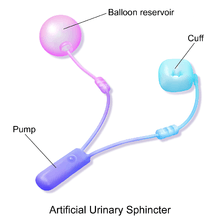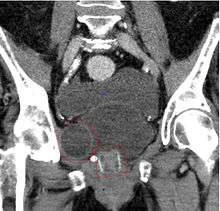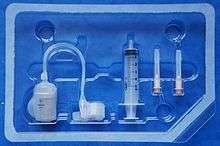Artificial urinary sphincter

An artificial urinary sphincter (AUS) is an implanted device to treat urinary incontinence in men. The AUS is designed to supplement the function of the natural urinary sphincter that restricts urine flow out of the bladder.
Description

Although models vary, the common thread among all designs is a mechanical constriction mechanism (either liquid-inflatable or spring-loaded band) placed around the urethra, and an externally accessible control mechanism allowing the user to relieve the constriction to allow urination.[1]
Inflatables
Most AUS devices employ an inflatable clamp or collar that is fitted around the urethra to supplement or supplant the function of the natural spincter.[1] The clamp is inflated automatically and deflated manually by a pump that, depending on the model, is variously placed within the scrotum (for models intended for adult men), or within the abdomen with a valve release button accessible by a percutaneous puncture.[1] Some designs incorporate reservoirs placed in the Retzius space that increase the pressure on the collar during periods of abdominal exertion, the better to constrict flow when intra-bladder pressure increases.[1]

Mechanical tape
At least one AUS device utilizes a length of tape fixed in a loop around the urethra. A mechanical control device implanted in the scrotum consists of an arrangement of springs that, when activated, constrict the tape loop around the urethra to prevent urine flow. When deactivated by the user, the tape loop relaxes, allowing urine flow.[1]
Risks
Possible risks arising from the implantation of the AUS include:
- Harm to the urethra or bladder
- Difficulties emptying the bladder requiring self-catheterization[1]
- Worsened urinary incontinence
- Failure or wear of the implant, in which case further surgery is required in order to remove it
Efficacy
AUS devices offer significant improvement in urinary continence. Continency indices of up to 97% have been reported in one study.[1] However, immediate post-operative and long-term complications remain problematic, with eventual device removal rates between 5% and 40%.[1]
Manufacturers
AUS devices include:[1]
- FlowSecure, manufactured by RBM-Med
- Periurethral Constrictor, manufactured by Silimed, Rio de Janeiro, Brazil
- ZSI 375, manufactured by ZEPHYR Surgical Implants, Switzerland
- Tape Mechanical Occlusive Device, manufactured by GT Urological, Minneapolis, MN
References
- 1 2 3 4 5 6 7 8 9 Vakalopoulos, Ioannis; Kampantais, Spyridon; Laskaridis, Leonidas; Chachopoulos, Vasileios; Koptsis, Michail; Toutziaris, Chrysovalantis. "New Artificial Urinary Sphincter Devices in the Treatment of Male Iatrogenic Incontinence". Advances in Urology. 2012. doi:10.1155/2012/439372.